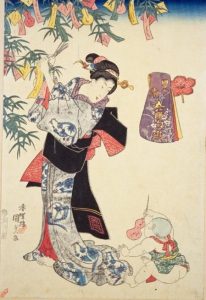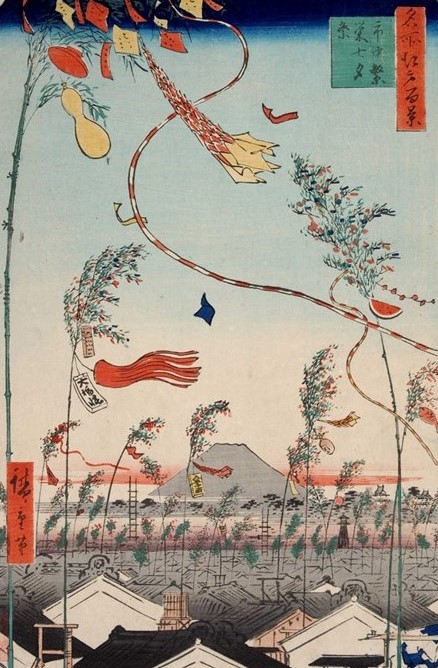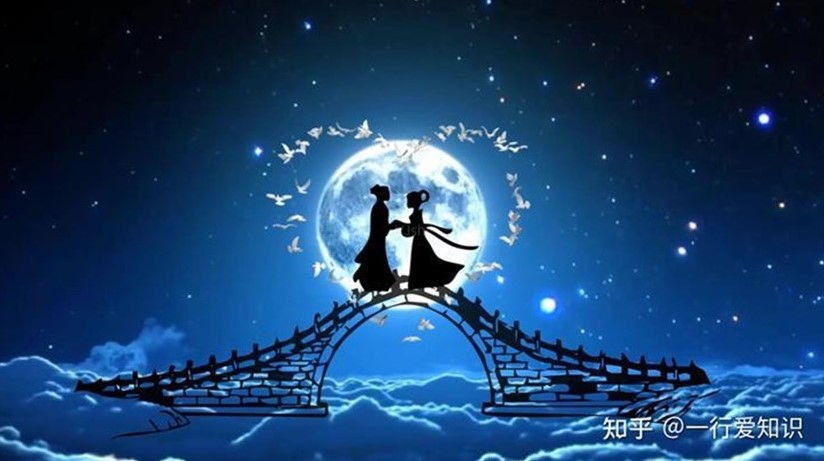This year the Evening of Sevens, or the Double Seventh Festival (meaning, a celebration on the seventh day of the seventh lunar month), will fall on the 22nd of August. Double Seventh is being celebrated throughout East Asia though each country has its own origin stories and has developed unique and distinctive ways of observing the festival. In this post we’ll briefly explore the characteristics and history of the festival in China, Japan, and Korea. There will be a resource list at the end for you to learn more about the festival.
Qixi Festival, or, the Chinese Valentine’s Day
According to the South China Morning Post, a Hong Kong newspaper, Qixi (七夕 evening of sevens) festival is a special time of year for the Chinese to “dream of love, the moon, and the Milky Way.” Traditionally called the Festival of Qiqiao (乞巧, to beg for dexterity), the Qixi festival originated from the tragic myth of the Weaving Maid (织女) and the Cowherder (牛郎 Niulang), star-crossed lovers who are only permitted to meet once a year on the double seventh in the Milky Way. The two lovers eventually became stars, Vega and Altair respectively, which appears brightly across the Milky Way at this time of year. In China, where this tradition began, young women used to pray to Zhinu for talent in needlework, an attribute of a good wife. These days, the Double Seventh Festival has become the most romantic day for the Chinese, when couples celebrate each other by gift giving and going on dates.
Chilseok (七夕, “Seventh Evening”)
According to the Encyclopedia of Korean Culture, Chilseok is the localized variant of the Chinese Qixi with a similar love story attached. Gyeonu (牽牛, “Cowherd”) and Jingnyeo(織女, “Weaver”) were both hardworking young folks who were well regarded by the Emperor of Heaven(玉皇上帝), but after marrying, they were so enamored of one another that they let the cows wander and the loom gather dust. The annoyed Emperor ordered them to be separated, with the Milky Way (銀河水, “Silver River”) flowing between them, but they were allowed to meet once a year on the seventh day of the seventh month. On the banks of the Silver River, the two saw each other but realized they could not cross the starry waters and began to cry. Moved by their tears (or, according to some, desperate to stop the flooding of earth that was caused by those tears!), crows and magpies volunteered to fly up and make a bridge of their bodies (烏鵲橋, “Crow-Magpie Bridge”): this is why around this time, crows and magpies have bald heads from being stepped on by the couple. If it rains on this day it is said to be the tears of Gyeonu and Jingnyeo. The day itself is not typically celebrated in a huge way, but there are some themed local festivals and most people are aware of the love story. A matchmaking friend of both partners in a couple (especially if they helped overcome some obstacle for the two) may jokingly be referred to as having been, or set up, their 烏鵲橋.
Chang Yu-sŭng, in his analysis of Hong Sŏng-mo’s Tongguk sesigi(東國歲時記), thought that Koreans of the Choseon period were aware of Ch’ilseok, and wrote poems on the theme of the myth but did not really celebrate it as a lover’s festival as done in China. However, in the Tongguk sesigi there is another tradition relating to Ch’ilseok: on the day people would bring out their books and clothes to dry in the sun (presumably to get rid of the humidity of the rainy season before the onset of the busy harvest season, followed by winter). Of this practice, there is a record as late as the 20th century: Imamura Tomo’s 『朝鮮風俗集』(A Collection of Korean Customs, 1914), a Japanese official’s record of Koreans’ customs of this time.
Tanabata in Japan

Utagawa Kunisada (1786-1864), Tanabata, woodblock print, National Diet Library, https://dl.ndl.go.jp/en/pid/1305288
According to the Encyclopedia of Japan and Nihon dai hyakka zensho, the Qiqiao Festival arrived from China in Japan in the 8th century, and the two stars, the Weaving Maid (織女Shokujo) and the Cowherder (牽牛 Kengyū) were revered among the aristcrats and in the imperial court at the time. Festivities similar to what we observe in the present started during the Edo period (1600-1868), when the festival as part of the Five Annual Ceremonies (Gosekku五節供) was officially established, and decorated bamboo branches began to appear in the cities. The present-day festival is a product of the historical mixing and blending of the Chinese Qiqiao customs, native traditions and folklore, and Buddhist observances honouring the ancestral spirits (Bon Festival, Urabon’e 盂蘭盆会). There are considerable regional variations in how the festival is celebrated, but a typical feature of the Tanabata festival is the display of decorated bamboo branches. Long narrow strips of colourful paper written with wishes and aspirations and other ornaments adorn the bamboo branches. Unlike China and Korea, the Evening of Seventh is generally celebrated on July 7th in the Gregorian calendar in Japan.

Andō Hiroshige (1797-1858), Meisho Edo hyakkei: Shichū han’ei tanabata matsuri, woodblock print, Tokyo Metropolitan Library, https://archive.library.metro.tokyo.lg.jp/da/detail?tilcod=0000000003-00055238
Resources
Japanese
- Children’s picture book retelling the Chinese Qixi Title: Tanabata http://resolve.library.ubc.ca/cgi-bin/catsearch?bid=10141405 Book cover image is available here: https://www.fukuinkan.co.jp/book/?id=269A
- A picture book for young children with a story of animal friends decorating bamboo branches for Tanabata. Title: Minna no onegai. http://resolve.library.ubc.ca/cgi-bin/catsearch?bid=12463991 Book cover image available at https://www.holp-pub.co.jp/book/b485342.html
- A journal article in English on Amewakahiko sōshi (Tale of Amewakahiko; 15th century) as a legendary origin of Tanabata in Japan. https://muse.jhu.edu/article/595254
- Amewakahiko monogatari emaki (Illustrated Tale of the Heavenly Young Prince), 17th century, Suntory Museum of Art, https://www.suntory.co.jp/sma/collection/data/detail?id=612
- Tale of Tanabata (Muromachi period) reproduced in volume 7 of Kyōto Daigaku zō Muromachi monogatari http://resolve.library.ubc.ca/cgi-bin/catsearch?bid=2571659
Korean
- Kyŏnu wa Chingnyŏ, a children’s picturebook version
- Also included in v.2 of Oegugin ŭl wihan Han’gugŏ ilki, a collection of Korean folktales written for language learners
Chinese
- A set of children’s books introducing festivals in China. Volume 7 is about Qixi https://resolve.library.ubc.ca/cgi-bin/catsearch?bid=8966384
- Chinese language reader on the story of Weaver and Cowherd https://resolve.library.ubc.ca/cgi-bin/catsearch?bid=10079691


